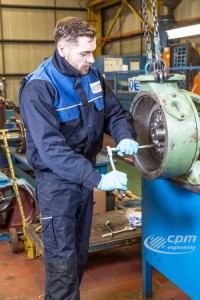Why Mechanical Seals Fail
Mechanical Seal failures seem to fall into four broad categories:
- The seal motion was restricted and the faces opened.
- Heat caused the 0-rings to deteriorate.
- The seal materials were attacked by the fluid sealed.
- The seal was installed incorrectly.
Mechanical Seals motion restricted:
The spring-loaded (dynamic) seal face constantly moves to maintain full face contact with the stationary seal face. The main reasons for this movement are
- The stationary face is not perpendicular to the pump shaft.
- The pump has bearing end play. This means that the shaft moves back and forth a few thousandths of an inch at frequent but random intervals.
- There is some impeller unbalance causing shaft whip.
- The pump is operated away from its BEP, causing side loads on the shaft.
- There is thermal shaft growth and Pump vibration that affects the seal.

Here are the major conditions that can restrict movement of the spring loaded mechanical seals face:
- Solids have collected in the seal or around the dynamic seal ring.
- The fluid sealed has caused the dynamic 0-ring to swell.
- The temperature limit of the dynamic 0-ring has been exceeded and the 0-ring has lost its elasticity (compression set) or become hard.
- Spring compression is inadequate because of incorrect installation.
- Solids in the stuffing box, gasket protrusion or other foreign material restrict the motion of the dynamic seal ring.
Thermal degradation of Mechanical Seal 0-rings:
O-rings are the one part of a mechanical seal that are sensitive to heat because of the way they are manufactured. The ingredients are mixed together, put in a mould and cured at high temperature for a specific time. The compound will then assume the shape of the mould and its hardness, or durometer, will increase. When the 0-ring is placed in an 0-ring groove in a seal and heated to a temperature beyond its recommended limit, the curing process will continue and the 0-ring will take a compression set. This means that the 0-ring has lost some of its resilience and squeeze, and fluid may leak past the 0-ring. The higher the temperature, the shorter the time before the 0-ring takes a compression set. When an 0-ring is exposed to high temperature for a long period, it will become hard and brittle, causing mechanical seals failure.
Since heat is often a problem and seldom helps the mechanical seal application, what can be done about it?
- Use a balanced seal to minimize the heat generated by the seal.
- Use low-friction face materials. Carbon vs silicon carbide is the best choice.
- Use a clean liquid flush or product recirculation to carry away heat.
Mechanical Seal materials attacked:
When the correct materials are not selected,
- The 0-rings may swell locking up the mechanical seal,
- The mechanical seal faces may deteriorate rapidly, and
- The metal seal components may corrode.
All can cause the mechanical seals to fail.
Mechanical seals installed incorrectly:
Many mechanical seals fail at initial start-up or prematurely because they were not installed correctly. Cartridge seals eliminate all measurement, protect the seal faces from contamination and are easy to install. With these seals, installation problems are minimized. The Outside seal is preset and requires no installation measurement. Only in-line seals require careful measurement to insure correct installation. By following the mechanical seals installation instructions, step-by-step correct seal installation is easily achieved.

For more information contact CPM Engineering on 0161 865 6161 or info@cpm-uk.com
Source: MechanicalSeals.Net
